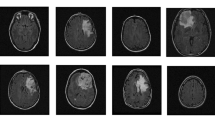Deep learning is an actively developing technology of machine learning. Its medical applications are the subject of ever increasing research worldwide. The algorithm for detection of enlargement of the ventricular system of the brain was tested using 200 series of digital MRI brain scan images captured in T2-weighted mode in the axial plane. The obtained digital data were divided into three parts: 1) training set; 2) validation set used to determine when to stop learning and select a model in terms of the best parameter; 3) test set for qualimetric assessment of the model. The accuracy of predicting the deviation from normal (i.e., the enlargement of the ventricular system of the brain) was 97.5%; sensitivity, 96.3%; specificity, 98.1%.
Similar content being viewed by others
References
Rekate, H. L., “The definition and classification of hydrocephalus: A personal recommendation to stimulate debate,” Cerebrospinal Fluid Res., 5, No. 1, 1-7 (2008).
Adams, R., Fisher, C., Hakim, S., et al., “Symptomatic occult hydrocephalus with normal cerebrospinal fluid pressure: A treatable syndrome,” N. Engl. J. Med., 273, No. 3, 117-126 (1965).
Bir, S. C., Patra, D. P., Maiti, T. K., et al., “Epidemiology of adult-onset hydrocephalus: Institutional experience with 2001 patients,” Neurosurg. Focus, 41, No. 3, E5 (2016).
Dewan, M. C., Rattani, A., Mekary, R., et al., “Global hydrocephalus epidemiology and incidence: Systematic review and meta-analysis,” J. Neurosurg., 130, No. 4, 1065-1079 (2018).
Martin-Laez, R., Caballero-Arzapalo, H., Lopez-Menendez, L. A., et al., “Epidemiology of idiopathic normal pressure hydrocephalus: A systematic review of the literature,” World Neurosurg., 84, No. 6, 2002-2009 (2015).
Klassen, B. T. and Ahlskog, J. E., “Normal pressure hydrocephalus: How often does the diagnosis hold water?” Neurology, 77, No. 12, 1119-1125 (2011).
Lam, S., Reddy, G. D., Lin, Y., et al., “Management of hydrocephalus in children with posterior fossa tumors,” Surg. Neurol. Int., 6, Supplement 11, 346-348 (2015).
Dorner, L., Fritsch, M. J., Stark, A. M., et al., “Posterior fossa tumors in children: How long does it take to establish the diagnosis?” Child’s Nervous System, 23, No. 8, 887-890 (2007).
Prasad, K. S. V., Ravi, D., Pallikonda, V., et al., “Clinicopathological study of pediatric posterior fossa tumors,” J. Pediatr. Neurosci., 12, No. 3, 245-250 (2017).
Prabhuraj, A., Sadashiva, N., Kumar, S., et al., “Hydrocephalus associated with large vestibular schwannoma: Management options and factors predicting requirement of cerebrospinal fluid diversion after primary surgery,” J. Neurosci. Rural Pract., 8, Supplement 1, 27-32 (2017).
Hu, J., Western, S., and Kesari, S., “Brainstem glioma in adults,” Front. Oncol., 6, 180 (2016).
Murphy, K. P., Machine Learning: A Probabilistic Perspective, MIT Press (2012).
Krizhevsky, A., Sutskever, I., and Hinton, G. E., “Imagenet classification with deep convolutional neural networks,” Adv. Neural Info. Proc. Syst., 25, 1097-1105 (2012).
Kohli, M., Prevedello, L. M., Filice, R. W., et al., “Implementing machine learning in radiology practice and research,” Am. J. Roentgenol., 208, No. 4, 754-760 (2017).
Erickson, B. J., Korfiatis, P., Akkus, Z., et al., “Machine learning for medical imaging,” RadioGraphics, 37, No. 2, 505-515 (2017).
Lakhani, P. and Sundaram, B., “Deep learning at chest radiography: Automated classification of pulmonary tuberculosis by using convolutional neural networks,” Radiology, 284, No. 2, 574-582 (2017).
Zhang, N., Yang, G., Gao, Z., et al., “Deep learning for diagnosis of chronic myocardial infarction on nonenhanced cardiac cine MRI,” Radiology, 291, No. 3, 606-617 (2019).
Soffer, S., Ben-Cohen, A., Shimon, O., et al., “Convolutional neural networks for radiologic images: A radiologist’s guide,” Radiology, 290, No. 3, 590-606 (2019).
Cicero, M., Bilbily, A., Colak, E., et al., “Training and validating a deep convolutional neural network for computer-aided detection and classification of abnormalities on frontal chest radiographs,” Invest. Radiol., 52, No. 5, 281-287 (2017).
Yosinski, J., Clune, J., Bengio, Y., et al., “How transferable are features in deep neural networks?” in: NIPS’14: Proc. 27th Int. Conf. on Neural Information Processing Systems, Vol. 2 (2014), pp. 3320-3328.
Russakovsky, O., Deng, J., Su, H., et al., “Imagenet large scale visual recognition challenge,” Int. J. Comput. Vis., 115, No. 3, 211-252 (2015).
Selvaraju, R. R., Cogswell, M., Das, A., et al., “Grad-cam: Visual explanations from deep networks via gradient-based localization,” in: Proc. IEEE Int. Conf. on Computer Vision (2017), pp. 618-626.
Komotar, R. J., Starke, R. M., and Connolly, E. S., “Brain magnetic resonance imaging scans for asymptomatic patients: Role in medical screening,” Mayo Clin. Proc., 83, No. 5, 563-565 (2008).
Vernooij, M. W., Ikram, M. A., Tanghe, H. L., et al., “Incidental findings on brain MRI in the general population,” N. Engl. J. Med., 357, No. 18, 1821-1828 (2007).
Brugulat-Serrat, A., Rojas, S., Bargallo, N., et al., “Incidental findings on brain MRI of cognitively normal first-degree descendants of patients with Alzheimer’s disease: A cross-sectional analysis from the alfa (Alzheimer and families) project,” BMJ Open, 7, No. 3, e013215 (2017).
Celtikci, E., “A systematic review on machine learning in neuro-surgery: The future of decision-making in patient care,” Turk. Neurosurg., 28, No. 2, 167-173 (2018).
Azimi, P. and Mohammadi, H. R., “Predicting endoscopic third ventriculostomy success in childhood hydrocephalus: An artificial neural network analysis,” J. Neurosurg. Pediatr., 13, 426-432 (2014).
Habibi, Z., Ertiaei, A., Nikdad, M. S., et al., “Predicting ventricu-loperitoneal shunt infection in children with hydrocephalus using artificial neural network,” Child’s Nervous System, 32, 2143-2151 (2016).
Author information
Authors and Affiliations
Corresponding author
Additional information
Translated from Meditsinskaya Tekhnika, Vol. 55, No. 4, Jul.-Aug., 2021, pp. 52-55.
Rights and permissions
About this article
Cite this article
Mishinov, S.V., Demyanchuk, A.I., Pushkina, E.V. et al. Identification of Enlargement of the Ventricular System of the Brain Using Machine Learning. Biomed Eng 55, 297–301 (2021). https://doi.org/10.1007/s10527-021-10122-x
Received:
Published:
Issue Date:
DOI: https://doi.org/10.1007/s10527-021-10122-x




